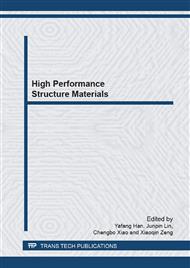[1]
Y. Kojima, Project of Platform Science and Technology for Advanced Magnesium Alloys, Materials Transactions. 42 (7) (2001) 1154-1159.
DOI: 10.2320/matertrans.42.1154
Google Scholar
[2]
J. Buha, Natural ageing in magnesium alloys and alloying with Ti, Journal of Materials Science. 43 (2008) 1220-1227.
DOI: 10.1007/s10853-007-2250-1
Google Scholar
[3]
X.S. Huang, K. Suzuki, A. Watazu, I. Shigematsu, N. Saito, Microstructure and texture of Mg-Al-Zn alloy processed by differential speed rolling, Journal of Alloys and Compounds. 457 (1-2) (2008) 408-412.
DOI: 10.1016/j.jallcom.2007.02.144
Google Scholar
[4]
J.B. Lin, Q.D. Wang, L.M. Peng, H.J. Roven, Microstructure and high tensile ductility of ZK60 magnesium alloy processed by cyclic extrusion and compression, Journal of Alloys and Compounds. 476 (1-2) (2009) 441-445.
DOI: 10.1016/j.jallcom.2008.09.031
Google Scholar
[5]
T. Mukai, M. Yamanoi, H. Watanabe, K. Higashi, Ductility enhancement in AZ31 magnesium alloy by controlling its grain structure, Scripta Materialia. 45 (2001) 89-94.
DOI: 10.1016/s1359-6462(01)00996-4
Google Scholar
[6]
J.B. Lin, Q.D. Wang, L.M. Peng, T. Peng, Effect of the cyclic extrusion and compression processing on microstructure and mechanical properties of as-extruded ZK60 magnesium alloy, Materials Transactions. 49 (5) (2008) 1021-1024.
DOI: 10.2320/matertrans.mc200766
Google Scholar
[7]
M. Mabuchi, H. Iwasaki, K. Yanase, K. Higashi, Low temperature superplasticity in an AZ91 magnesium alloy processed by ECAE, Scripta Materialia. 36 (1997) 681-686.
DOI: 10.1016/s1359-6462(96)00444-7
Google Scholar
[8]
M. Mabuchi, T. Asahina, H. Iwasaki, K. Higashi, Experimental investigation of superplastic behaviour in magnesium alloys, Materials Science and Technology. 13 (1997) 825-831.
DOI: 10.1179/mst.1997.13.10.825
Google Scholar
[9]
Y.J. Chen, Q.D. Wang, J.G. Peng, C.Q. Zhai, Improving the Mechanical Properties of AZ31 Mg Alloy by High Ratio Extrusion, Materials Science Forum. 503-504 (2006) 865-870.
DOI: 10.4028/www.scientific.net/msf.503-504.865
Google Scholar
[10]
R.Z. Valiev, R.K. IsIamgaliev, I.V. Alexandrov, Bulk nanostructured materials from severe plastic deformation, Progress in Materials Science. 45 (2000) 103-189.
DOI: 10.1016/s0079-6425(99)00007-9
Google Scholar
[11]
H.K. Lin, J.C. Huang, High Strain Rate and/or Low Temperature Superplasticity in AZ31 Mg Alloys Processed by Simple High-Ratio Extrusion Methods, Materials Transactions. 43 (2002) 2424-2432.
DOI: 10.2320/matertrans.43.2424
Google Scholar
[12]
Y.M. Hwang, M.T. Yang, Study of Hydrostatic Extrusion Processes with Extra-High Extrusion Ratio, Key Engineering Materials. 233-236 (2003) 311-316.
DOI: 10.4028/www.scientific.net/kem.233-236.311
Google Scholar
[13]
D. Shangli, T. Imai, S.W. Lim, N. Kanetake, N. Saitob, I. Shigematsu, Superplasticity in Mg–Li–Zn Alloys Processed by High Ratio Extrusion, Materials and Manufacturing Processes. 23 (4) (2008) 336-341.
DOI: 10.1080/10426910701860954
Google Scholar
[14]
Y.N. Wang, C.J. Lee, H.K. Lin, C.C. Huang, J.C. Huang, Influence from Extrusion Parameters on High Strain Rate and Low Temperature Superplasticity of AZ Series Mg Base Alloys, Materials Science Forum. 426-432 (2003) 2655-2660.
DOI: 10.4028/www.scientific.net/msf.426-432.2655
Google Scholar
[15]
C.C. Huang, J.C. Huang, I.K. Lin, Y.M. Hwang, Processing Fine-Grained and Superplastic AZ31 Mg Tubes for Hydroforming, Key Engineering Materials. 271-271 (2004) 289-294.
DOI: 10.4028/www.scientific.net/kem.274-276.289
Google Scholar
[16]
X.N. Wang, F.G. Li, Y.H. Liu, Simulation of the FGH96 Superalloy Microstructural Changes under Different Deformation Conditions, Materials Science Forum. 575-578 (2008) 455-461.
DOI: 10.4028/www.scientific.net/msf.575-578.455
Google Scholar
[17]
H. Yada, Proceedings of conference of metallurgists, M. B. Winnipeg, G. E. Ruddle, A. F. Crawley (Eds. ), CIM, Canada, 1987, p.105.
Google Scholar


